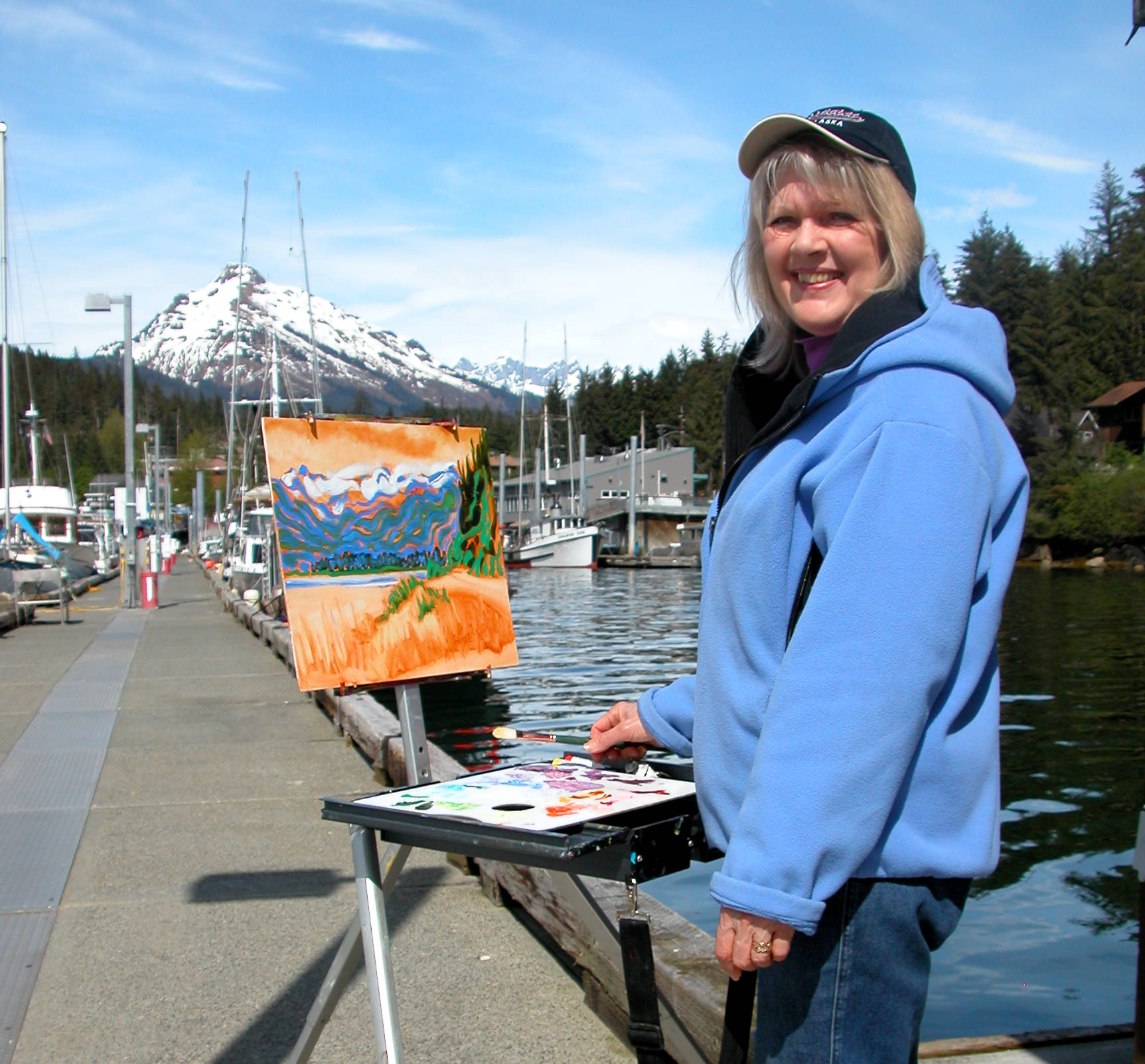Juneau artist Devita Stipek Writer has been painting with oils and acrylics for more than 40 years. Her abstract paintings feature Southeast landscapes, frequently of the sun setting, casting an array of vivid colors for her to capture on her canvas. She completes her paintings outdoors directly on the scene, a method known as plein air.
As a teenager, one of her drawings appeared on the cover of the Seattle Times’ Sunday magazine. She later attended the Cornish School of Allied Arts in the 1960s. Her work was exhibited at the New York Coliseum and at the Atkins Museum in Kansas City. She was also selected for the National Hallmark Award. She worked as a commercial artist and taught fine art in private schools in Juneau in the 1980s, and has had numerous solo exhibits in Juneau and in the state of Washington. Many of her large scale paintings are installed on Carnival Cruise Lines’ newer ships.
The Capital City Weekly caught up this prolific artist to learn about her art.
CM: How did you get started painting?
DSW: With the encouragement of teachers, I became serious about drawing and painting while very young. Later, at Cornish College of the Arts, I was fortunate to have instructors that were painters who did not teach much about technique but a lot about such things as color theory. I studied the work of many painters, which grew into my love of abstract expressionism.
CM: What does a day of painting look like for you?
DSW: With one eye on the weather, I single out a location that may have been on my mind for weeks or years. I scrape the old paint off my pallet and make sure tubes of color, brushes and pallet knives have not escaped my paint box. I keep easel, camp table and warm clothes in a big plastic container ready to go, and a wheelbarrow to carry it all to the right spot. I take my husband to provide muscle power because my entire painting outfit is quite heavy and sometimes I am working several hundred yards from my vehicle, a big red Ford truck. I feed the dog and fix a lunch and arrive on location at least three or four hours before sunset. If there are people around, I put on my headset to steer them away. I quickly become totally absorbed in painting. I work right through sunset until dark, usually needing a flashlight to get back to the truck. I might return to the same location two or three times to finish a painting. But I love it when it happens alla prima! (Editor’s note: “Alla prima” is an Italian phrase for a painting technique in which the artist paints everything in one sitting.)
CM: I’ve noticed you play with how the sun colors the water and mountains in your work. What draws you to these aspects of our Southeast landscape?
DSW: The low sun at these latitudes and the salt-filled atmosphere create effects that are unique. Over the course of a sunset, light and water change minute by minute. Wisps of fog appear and disappear. Tidal currents form graceful patterns on the water. As the sun nears the horizon, shadows lengthen and colors grow more intense. Time is short, forcing me to be spontaneous and decisive, and this is important because everything is moving, changing. At my best, I capture what I call the underlying abstract design of a moment in time, the essence. There are some unusual colors in our sunsets and my paintings express colors that may be only implied, yet, if I have been successful, the colors ring true and the mind of the viewer sees more than what is there.
CM: How has your artistic style evolved through the years?
DSW: As I strive towards some ideal that exists only, I suppose, in my subconscious, my work is evolving but not by any conscious change in style. Painting outdoors “plein air” is quite rigorous, and I don’t have the stamina I did when I was younger, but this is still the only way a painting “happens” for me. Even my murals are birthed from a small painting done outdoors. Perhaps I’ve become more comfortable with myself as a painter, more confident.
CM: What artists have influenced you?
DSW: I find myself attracted to Post-Impressionism and, more particularly, the Fauvists Emil Nolde and Georges Rouault, with whom I share a similar spiritual heritage. (Editor’s note: The Fauve painters, who appeared at the start of the 19th century, broke with impressionism and older techniques in favor of bold colors and a different way of representing the world.) And of course, Vincent van Gogh.
CM: As an artist who has been painting for decades, do you have any advice for up-and-coming artists?
DSW: Learn to draw. Learn all you can about technical aspects of materials and tools. Study the work of artists you admire, I mean go see some paintings. The city and state museums, the Met (the Metropolitan Museum of Art in New York City.) Study their lives. Read what they say about their own work. Armed with this head knowledge, paint until it bypasses your brain and flows from your heart. Be bold. Learn to love, trust and be kind, because you won’t be rich.
CM: Where can people find your work in person or online?
Glacier paintings can be found at Mendenhall Glacier Visitor Center (bookstore), which is open year-round (Friday-Sunday 10 a.m.-4 p.m.). A much broader range of work is shown at the Juneau Artists Gallery, downtown (Tuesday-Satureday 11 a.m.-6 p.m.). This week, for the first time, I’m showing some work at the Mendenhall Mall Arts and Crafts fair, and I find I really enjoy talking to folks about my work. I have a website at dswriter.com; most of the paintings shown are already sold.
• Clara Miller is the staff writer for the Capital City Weekly. She can be reached at clara.miller@capweek.com.

